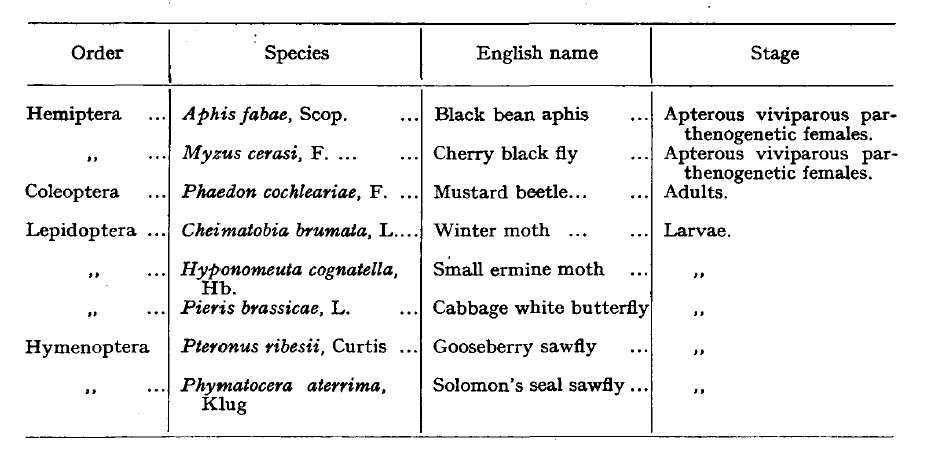Actions for selected content:
Most cited
This page lists all time most cited articles for this title. Please use the publication date filters on the left if you would like to restrict this list to recently published content, for example to articles published in the last three years. The number of times each article was cited is displayed to the right of its title and can be clicked to access a list of all titles this article has been cited by.
- Cited by 4
An Arsenic-resistant Tick and its Control with “Gammexane” Dips.—Part II
-
- Published online by Cambridge University Press:
- 10 July 2009, pp. 207-226
-
- Article
- Export citation
- Cited by 4
Impact of human activity on the distribution of native and non-native cockroach species (Dictyoptera) in La Réunion and Mayotte
-
- Published online by Cambridge University Press:
- 09 March 2007, pp. 399-406
-
- Article
- Export citation
- Cited by 4
Suitability of multiple Mediterranean oak species as a food resource for Reticulitermes grassei Clément (Isoptera: Rhinotermitidae)
-
- Published online by Cambridge University Press:
- 06 November 2017, pp. 532-539
-
- Article
- Export citation
- Cited by 4
Geographical variation in life-history traits suggests an environmental-dependent trade-off between juvenile growth rate and adult lifespan in a moth
-
- Published online by Cambridge University Press:
- 23 January 2019, pp. 626-632
-
- Article
- Export citation
- Cited by 4
Population dynamics of the white wax scale, Ceroplastes destructor (Hemiptera: Coccidae), on citrus in South Africa, with implications for biological control
-
- Published online by Cambridge University Press:
- 09 March 2007, pp. 307-315
-
- Article
- Export citation
- Cited by 4
Biological and molecular characterization of Hessian fly (Diptera: Cecidomyiidae) from Israel
-
- Published online by Cambridge University Press:
- 08 May 2012, pp. 632-643
-
- Article
- Export citation
- Cited by 4
Larval species composition and genetic structures of Carposina sasakii, Grapholita dimorpha, and Grapholita molesta from Korea
-
- Published online by Cambridge University Press:
- 31 July 2017, pp. 241-252
-
- Article
- Export citation
- Cited by 4
Potential for classical biological control of the potato bug Closterotomus norwegicus (Hemiptera: Miridae): description, parasitism and host specificity of Peristenus closterotomae sp. n. (Hymenoptera: Braconidae)
-
- Published online by Cambridge University Press:
- 09 March 2007, pp. 421-431
-
- Article
- Export citation
- Cited by 4
Implications of using two natural enemies of Tuta absoluta (Lepidoptera: Gelechiidae) toward tomato yield enhancement
-
- Published online by Cambridge University Press:
- 07 January 2019, pp. 617-625
-
- Article
- Export citation
- Cited by 4
Interspecific competition between Snellenius manilae and Meteorus pulchricornis, larval parasitoids of Spodoptera litura
-
- Published online by Cambridge University Press:
- 08 July 2015, pp. 583-588
-
- Article
- Export citation
- Cited by 4
The influence of nutritional history on the functional response of Geocoris pallidipennis to its prey, Myzus persicae
-
- Published online by Cambridge University Press:
- 03 July 2014, pp. 702-706
-
- Article
- Export citation
- Cited by 4
Molecular characterization and phylogeny of Kalotermes populations from the Levant, and description of Kalotermes phoeniciae sp. nov.
-
- Published online by Cambridge University Press:
- 17 March 2015, pp. 285-293
-
- Article
- Export citation
- Cited by 4
Reproductive efficiency of the bethylid wasp Cephalonomia tarsalis: the influences of spatial structure and host density
-
- Published online by Cambridge University Press:
- 03 October 2016, pp. 139-147
-
- Article
- Export citation
- Cited by 4
Weeds and natural enemy regulation of insect pests in upland rice; a case study from West Africa
-
- Published online by Cambridge University Press:
- 09 March 2007, pp. 391-402
-
- Article
- Export citation
- Cited by 4
Inheritance of key life-history traits in crosses between northern and southern populations of the cabbage beetle Colaphellus bowringi (Coleoptera: Chrysomelidae)
-
- Published online by Cambridge University Press:
- 15 February 2021, pp. 420-428
-
- Article
- Export citation
- Cited by 4
Effects of photoperiod and relative humidity on diapause termination and post-winter development of Rhagoletis cerasi pupae
-
- Published online by Cambridge University Press:
- 12 March 2020, pp. 588-596
-
- Article
-
- You have access
- Open access
- HTML
- Export citation
- Cited by 4
Less is more: partial larvicidal efficacy of plant leachate leads to larger Aedes aegypti mosquitoes
-
- Published online by Cambridge University Press:
- 07 August 2023, pp. 684-692
-
- Article
- Export citation
- Cited by 4
Assessment of Napier millet (Pennisetum purpureum×P. glaucum) and sorghum (Sorghum bicolor) trap crops for the management of Chilo partellus on maize
-
- Published online by Cambridge University Press:
- 24 October 2008, pp. 131-137
-
- Article
- Export citation
- Cited by 4
A Laboratory Comparison of the Toxicity as a Contact Poison of DDT with Nicotine, Derris Products and the Pyrethrins
-
- Published online by Cambridge University Press:
- 10 July 2009, pp. 469-496
-
- Article
- Export citation
- Cited by 4
The Susceptibility of fourth-stage Larvae of Anopheles gambiae to DDT and Dieldrin
-
- Published online by Cambridge University Press:
- 10 July 2009, pp. 1-6
-
- Article
- Export citation

